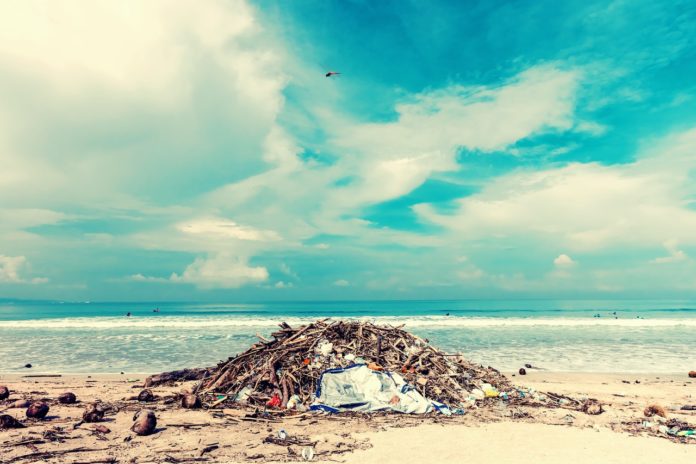Ordering takeout may be a great way to support restaurants through the COVID-19 pandemic, but the plastic waste generated by the takeout food industry is having a devastating impact on our oceans.
This was the key finding of a recent study published in Nature Sustainability, which combined datasets from around the world to provide the most comprehensive analysis of ocean litter to date. The study was an international collaboration between scientists from 10 different countries, and included contributions from Peter S. Ross, an adjunct professor in the University of British Columbia’s Department of Earth, Ocean and Atmospheric Sciences.
The most comprehensive analysis of ocean litter to date
For years, plastics have been the most common pollutant littering beaches and oceans around the world. Studies have shown that plastics can travel incredible distances along ocean currents, reaching as far as the most remote regions of the Arctic ocean and causing devastating damage to our environment in the process.
Yet while the scope of the world’s plastic problem may be clear, the exact origins and nature of all this plastic have remained largely unknown.
Because plastics often break down as they encounter rocks, strong waves, or other obstacles in the ocean, determining their exact origins can be tricky. This is particularly difficult when plastics break down into microplastics — tiny bits of plastic less than 5 millimetres in diameter — but can be a challenge for larger fragments of macro-plastics as well.
What’s more, the fact that plastic waste can travel so far in the ocean means that understanding where it all comes from requires a global perspective — and this is what the international collaboration behind the study set out to find.
To do this, the team combined data from scientific litter surveys and community science programs across the world to create a database of both plastic and non-plastic litter.
Notably, the team only included objects larger than 3 centimetres in their database. This excludes the aforementioned microplastics, which are particularly problematic but which are difficult to find and study due to their small size.
Since different surveys have different standards for classification, combining them wasn’t easy. The authors had to create a standard classification system for their own database and translate findings from individual surveys into this common system.
“Our initial idea was simple: to create a ranking of the top items littering the ocean,” explained Carmen Morales Caselles, a researcher at the University of Cádiz and first author of the study, in a press release.
“We soon realized that it was not such a simple task [… because] the existing information is based on disparate sampling methods and classification criteria.”
Using their standard classification system, the authors created a database of more than ten million pieces of litter found in seven types of aquatic environments around the world: from the open oceans, to riverbeds, to deep sea floors.
They further classified the items based on their composition. For example, plastic waste items might be sorted based on whether they were thin and flexible (like a plastic bag) or rigid and thick-walled (like a plastic takeout container). This allowed the team to determine where items originated, even if the items themselves had broken down into smaller pieces.
Takeout food and drink litter dominate
After creating their database, the authors searched for trends in the types and quantities of ocean litter around the world.
They found that the overwhelming majority of ocean litter is made up of plastic waste. This accounted for 80% of items in their database, with metal — the next most common material — accounting for just 7%.
The authors also found that this plastic waste was dominated by takeout consumer items, including plastic food containers, cutlery, bags, and wrappers. These items accounted for nearly half of the human-made waste found in oceans across the world.
“We were not surprised about plastic being 80% of the litter, but the high proportion of takeaway items did surprise us, which will not just be McDonald’s litter, but water bottles, beverage bottles like Coca-Cola, and cans,” Morales Caselles said in an interview with The Guardian.
Interestingly, some of the items that have received the most attention in plastic reduction campaigns — single-use straws and cotton bud sticks, for example — weren’t among the top contributors. Cotton buds made up less than 1% of the litter, indicating that plastic reduction campaigns need to widen their scope if they want to fully address the plastic problem.
“It’s good that there is action against plastic cotton buds, but if we don’t add to this action the top litter items, then we are not dealing with the core of the problem — we’re getting distracted.”
Bans on plastic take-out items may help
The authors go on to make a number of recommendations about how to address this growing issue.
One solution is to replace single-use plastic items with biodegradable alternatives. While these objects would likely still end up as litter, they wouldn’t remain in the environment as long, and would therefore have less of an impact over time.
The authors also advocate for bans on take-out plastic products where possible. While take-out containers might be difficult to ban outright, plastic bags are typically unnecessary and could be replaced by sustainable, multi-use alternatives.
In Canada, plans like these are already on the horizon. The government has committed to banning plastic grocery bags, cutlery, and food containers made from hard-to-recycle plastics by the end of 2021, asking business to offer sustainable alternatives instead. And given the global scope of this problem, it will be crucial for other countries around the world to follow through on similar plans.
Reducing plastic waste is a substantial challenge, but the insights offered by Morales Caselles’s study will help countries decide where to focus their efforts.
“Tackling marine litter pollution has become a major priority worldwide,” the authors concluded.
“[Our] insights into how plastic enters and moves in the marine environment [are] crucial to make progress towards a circular economy.”










































